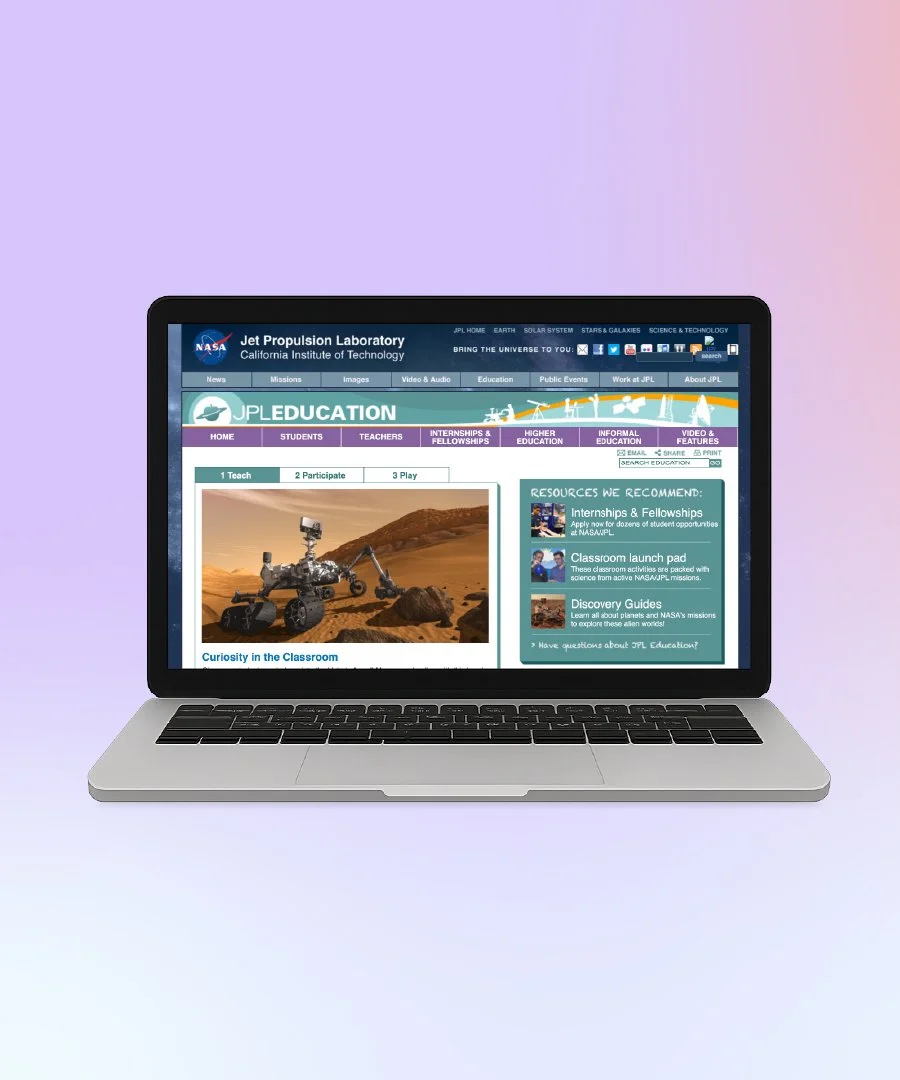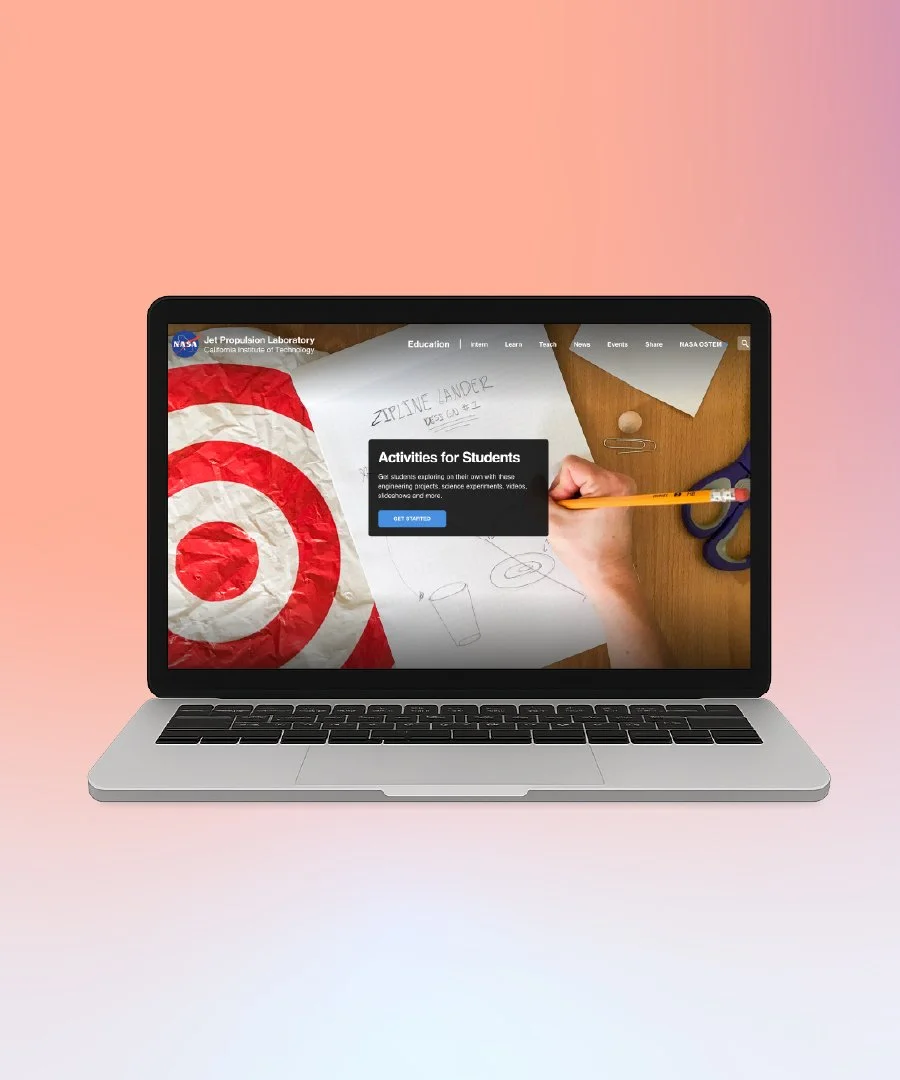Product Strategy
Leading a digital transformation
How a website redesign transformed not just JPL Education’s digital presence, but also its entire communications strategy.

Project Title: JPL Education Website, 2015 Redesign
Summary: Tasked with redesigning the public-facing JPL Education website in 2015, I led a strategy that redefined the site’s content and communications approach, growing annual traffic 500% to 4 million visitors, fueling engagement, and boosting the organization’s impact. The success earned my team funding in 2024 to take the next giant leap with an optimized UX—a project I also directed.
My Role: Product Strategy • Content Strategy • Communications Strategy • UX/Web Design • Information Architecture • CMS Design
Explore the pre-2015 version of the website on the Internet Archive.
The Opportunity:
Seeing the Bigger Picture
In 2015, JPL had revamped its flagship website, and I was tapped to lead the redesign of one of its major sections: the JPL Education website.
The project was part of a broader effort to unify the look and feel of JPL’s family of sites. But I saw a chance to do something bigger.
The Education Office had long struggled to raise the visibility of its programs for K–12, informal, and higher education audiences, and the website wasn’t telling the organization's story well. The team needed a site that could better showcase its offerings to both audiences and stakeholders.
The redesign was an opportunity to rethink not just the visuals, but the entire web strategy.
The Goals:
Redesign, Reimagined
The goals of the redesign were to:
Better showcase the value of JPL’s education programs to audiences and stakeholders.
Reach new and broader audiences.
Improve the user experience.
Make content easier to produce, manage, and scale.
Align the site with JPL’s flagship design system.
Explore the 2015 website redesign on the Internet Archive.
The Work:
A New Strategy Takes Shape
To get a better sense of what was working and what wasn’t, I started with a website audit. Amid broader structural and design needs, two issues stood out:
The site was overlooking two of its key audiences: K–12 teachers and students.
Nearly all the site traffic was driven by one source: the internship program listing.
By developing content to support K–12 teachers and students, we could address those issues and achieve some of our key goals: reaching new and broader audiences and showcasing the team’s value.
But there was one wrinkle. Content creation wasn’t a primary focus for the K–12 Education team at the time. While the team supported the approach, I needed to ensure that the strategy could flex and scale with them.
Here’s how I led the redesign and strategy, aligning the needs of the team, audiences, and the organization:
Conducted market research to explore how to structure and differentiate the JPL Education website.
Restructured the site to better showcase JPL Education’s offerings for distinct audiences.
Created two new sections, Teach and Learn, to house a searchable and filterable library of evergreen resources for K–12 audiences like lesson plans, student activities, and videos.
Collaborated closely with K-12 education specialists Ota Lutz and Lyle Tavernier to develop standardized templates for resources based on audience needs, including standards-aligned lesson plans.
Designed a custom CMS and editorial process tailored to the team’s needs and capabilities.
Led front-end design, improving the UX for existing sections like News, Events, and Internships.
Partnered with web developer Luis Espinoza to bring the new site and CMS to life.
Explore the current JPL Education website, redesigned in 2024.
The Impact:
A Transformation Unfolds
The new website launched in October 2015. Within the first year, traffic increased by 40%.
With a solid foundation and streamlined editorial process, we were able to launch new initiatives like Teachable Moments and the NASA Pi Day Challenge, which kept audiences coming back.
Traffic continued to grow by 30% or more each year, and before long, Teach and Learn became the site’s top-performing sections.
The digital resources—which grew from a collection of 80 to over 350—became the backbone of our entire strategy, from social media and email newsletters to educator workshops and major campaigns.
By 2023, the JPL education site was driving one-third of all traffic to the JPL flagship site. Traffic had grown by 500% since launch, reaching an average of 4 million visitors annually.
The impact was clear. Stakeholders across JPL and NASA began funding the team to create custom content and initiatives for their programs.
And in 2024, we secured funding to take the next giant leap with an optimized and evolved UX fit for our expanded audience and offerings.
Credits
Project Lead: Kim Orr
Communications Strategy: Kim Orr
Product Strategy: Kim Orr
Content Strategy: Kim Orr, Ota Lutz, Lyle Tavernier
UI/UX Design: Kim Orr
Information Architecture: Kim Orr
CMS Design & Editorial Strategy: Kim Orr
Web Development: Luis Espinoza
K–12 Education SMEs: Ota Lutz, Lyle Tavernier
Project Advisor: Jon Nelson
Project Stakeholders: Blaine Baggett, Parvin Kassaie, David Seidel



